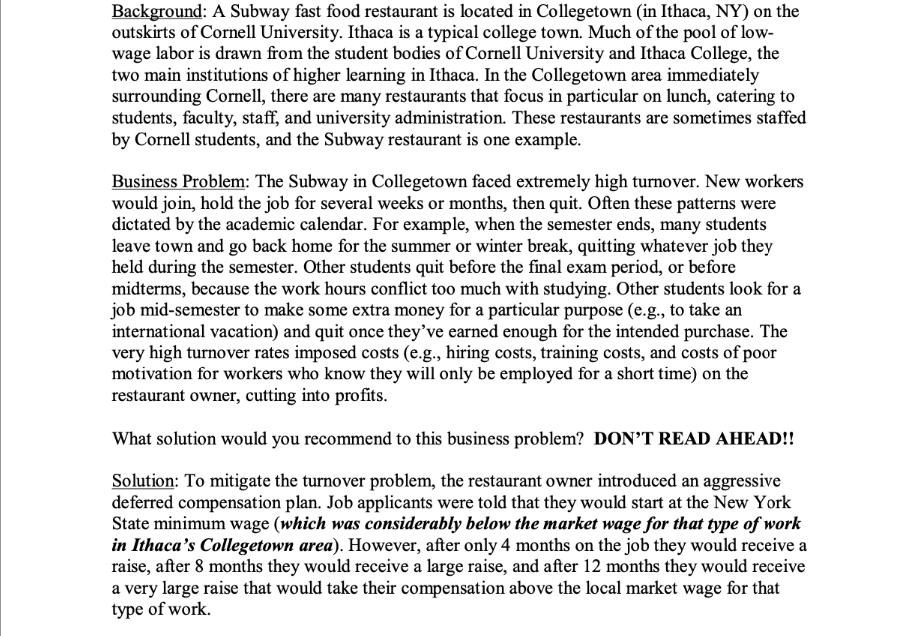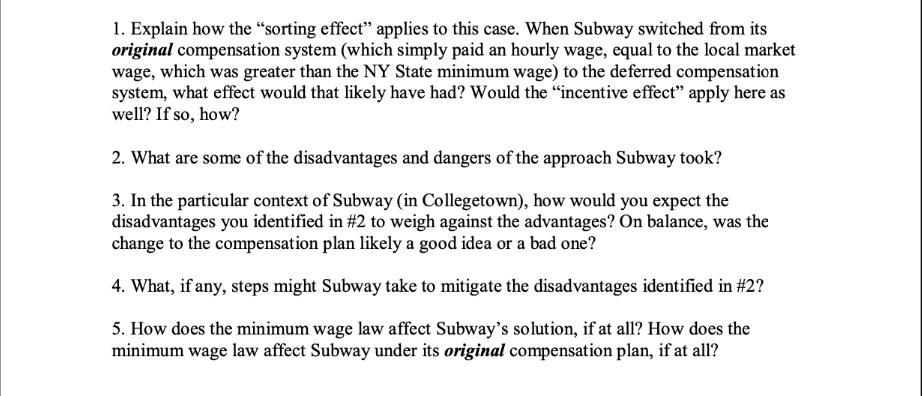Answered step by step
Verified Expert Solution
Question
1 Approved Answer
Background: A Subway fast food restaurant is located in Collegetown (in Ithaca, NY) on the outskirts of Cornell University. Ithaca is a typical college


Background: A Subway fast food restaurant is located in Collegetown (in Ithaca, NY) on the outskirts of Cornell University. Ithaca is a typical college town. Much of the pool of low- wage labor is drawn from the student bodies of Cornell University and Ithaca College, the two main institutions of higher learning in Ithaca. In the Collegetown area immediately surrounding Cornell, there are many restaurants that focus in particular on lunch, catering to students, faculty, staff, and university administration. These restaurants are sometimes staffed by Cornell students, and the Subway restaurant is one example. Business Problem: The Subway in Collegetown faced extremely high turnover. New workers would join, hold the job for several weeks or months, then quit. Often these patterns were dictated by the academic calendar. For example, when the semester ends, many students leave town and go back home for the summer or winter break, quitting whatever job they held during the semester. Other students quit before the final exam period, or before midterms, because the work hours conflict too much with studying. Other students look for a job mid-semester to make some extra money for a particular purpose (e.g., to take an international vacation) and quit once they've earned enough for the intended purchase. The very high turnover rates imposed costs (e.g., hiring costs, training costs, and costs of poor motivation for workers who know they will only be employed for a short time) on the restaurant owner, cutting into profits. What solution would you recommend to this business problem? DON'T READ AHEAD!! Solution: To mitigate the turnover problem, the restaurant owner introduced an aggressive deferred compensation plan. Job applicants were told that they would start at the New York State minimum wage (which was considerably below the market wage for that type of work in Ithaca's Collegetown area). However, after only 4 months on the job they would receive a raise, after 8 months they would receive a large raise, and after 12 months they would receive a very large raise that would take their compensation above the local market wage for that type of work. 1. Explain how the "sorting effect" applies to this case. When Subway switched from its original compensation system (which simply paid an hourly wage, equal to the local market wage, which was greater than the NY State minimum wage) to the deferred compensation system, what effect would that likely have had? Would the "incentive effect" apply here as well? If so, how? 2. What are some of the disadvantages and dangers of the approach Subway took? 3. In the particular context of Subway (in Collegetown), how would you expect the disadvantages you identified in #2 to weigh against the advantages? On balance, was the change to the compensation plan likely a good idea or a bad one? 4. What, if any, steps might Subway take to mitigate the disadvantages identified in #2? 5. How does the minimum wage law affect Subway's solution, if at all? How does the minimum wage law affect Subway under its original compensation plan, if at all?
Step by Step Solution
There are 3 Steps involved in it
Step: 1

Get Instant Access to Expert-Tailored Solutions
See step-by-step solutions with expert insights and AI powered tools for academic success
Step: 2

Step: 3

Ace Your Homework with AI
Get the answers you need in no time with our AI-driven, step-by-step assistance
Get Started


